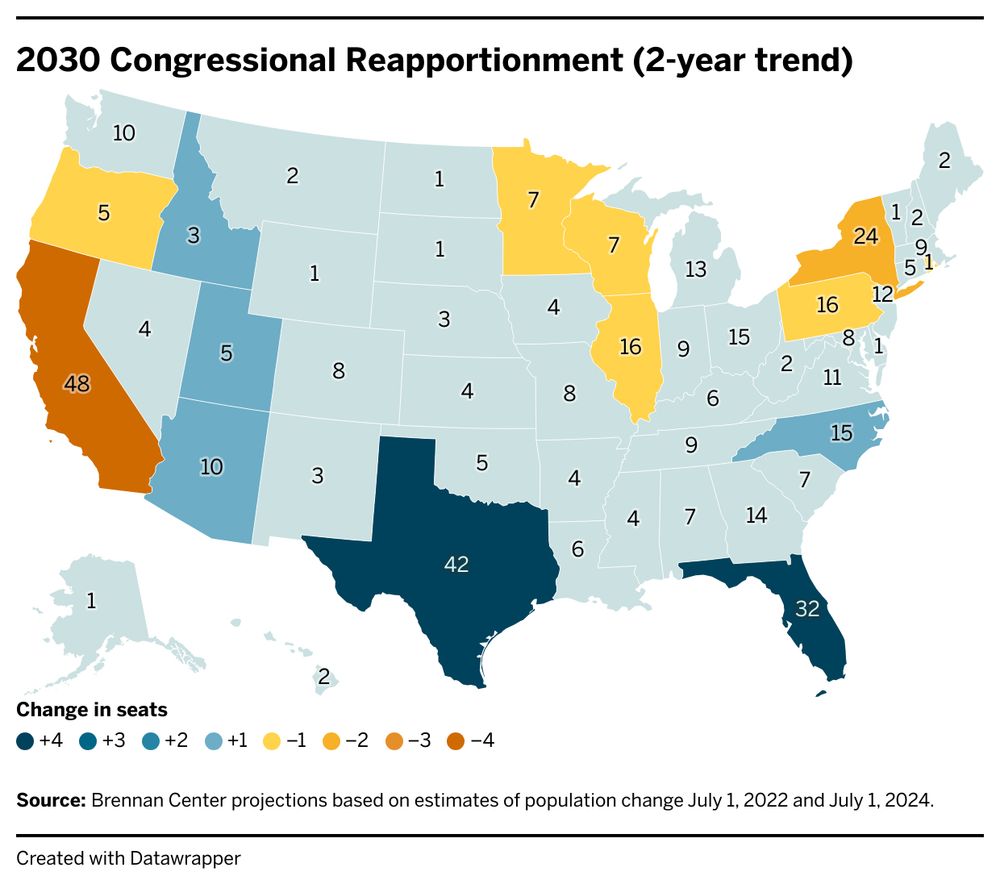Iowa is projected to maintain four U.S. House districts after 2030, according to population estimates the U.S. Census Bureau released on December 19. If that pans out, it would be our state’s longest stretch without losing a Congressional district in 100 years.
Michael Li, senior counsel for the Brennan Center’s Democracy Program, posted a map on social media on December 19, showing how reapportionment would affect each state. Iowa is among 36 states that would neither gain nor lose any U.S. House districts after the 2030 census, if population trends from the past two years hold. Three neighboring states—Illinois, Minnesota, and Wisconsin—are each expected to lose one seat, in line with a decades-long trend of relatively slower population growth in the Midwest and Northeast, compared to the South and West.
A century ago, Iowa had eleven Congressional districts. The state lost two U.S. House seats following the 1930 census, then dropped down to eight districts after 1940, seven districts after 1960, six districts after 1970, five districts after 1990, and four districts after 2010.
Much can change between now and the 2030 census. Economic conditions, natural disasters, and the Trump administration’s promised mass deportation policy will hit some states harder than others. But judging by the latest population estimates, Iowa does not appear to be in the danger zone.
KEEPING FOUR DISTRICTS WOULD HELP DEMOCRATS IN IA-03
Maintaining current levels of representation in Congress would benefit all Iowans, and would be particularly helpful to Democrats. Republicans have held all four of Iowa’s current U.S. House districts since 2023. But the first and third district are considered among the two dozen or so most competitive for Congressional elections, and the second district is potentially competitive. If Iowa dropped down to three House seats after the next census, Republicans might be favored to win them all, depending on the district lines.
As Polk County’s population continues to increase, residents of the Des Moines metro area will make up a larger share of voters in the third Congressional district, improving Democratic prospects of winning. IA-03 currently contains 21 counties, but Polk County alone accounted for 60.5 percent of the 426,546 ballots cast in the 2024 race between U.S. Representative Zach Nunn and Democratic challenger Lanon Baccam. Residents of Polk and Dallas counties cast just over 75 percent of ballots across the district.
It’s more likely than not that Dallas County (the fastest-growing in Iowa) will remain part of the third district after 2030. That’s because several suburbs of Des Moines contain parts of Polk and Dallas counties, and Iowa’s nonpartisan redistricting standards call for keeping cities within the same district when possible. If both Polk and Dallas stay in IA-03, the redrawn district would necessarily contain fewer small counties, where GOP candidates rack up big vote margins.
IOWA STILL GROWING MORE SLOWLY THAN U.S.
The Census Bureau estimated the total U.S. population at 340.1 million as of July 1, 2024, up nearly 1 percent from the July 2023 figures. That was “the fastest annual population growth the nation has seen since 2001 — a notable increase from the record low growth rate of 0.2% in 2021. The growth was primarily driven by rising net international migration,” the bureau announced in a news release.
Iowa’s population has been growing at a slower rate (about 0.72 percent), according to state-level datasets available on the Census Bureau’s website. The state’s population was estimated at 3,218,414 residents as of July 1, 2023, which increased to 3,241,488 as of July 2024.
If slow growth continues, Iowa may be among the unlucky states that lose a Congressional district after the 2040 census.


3 Comments
The Trend is Not Encouraging
Really don’t see anything happening in Iowa to attract new citizens to the state.
Laws hostile to women, a public school system in decline, the polluting of waterways and future budget problems won’t result in people lining up.
Those who look elsewhere will include doctors, teachers, trade workers and legal immigrants who have helped rural areas from declining even faster.
In a couple decades, this will be the legacy of Kim Reynolds and the majority Republican legislature.
It’s not too late to turn this around Iowa, but the window is closing.
Bill Bumgarner Sun 22 Dec 8:04 PM
The first thing that struck me about about the map...
…is that all of the growing states have known water supply problems, not to mention water quality problems. Texas, Arizona, Nevada, Idaho, Florida, and Virginia are all facing serious water challenges. Even in 2024, I continue to see, in news stories and elsewhere, assumptions that population growth is good and more population growth is better. But those water problems are almost certainly going to get worse, and there will be political consequences.
PrairieFan Mon 23 Dec 12:01 AM
6 districts
Miss the days when Iowa had six congressional districts – some of the younger readers have no idea that we had six US House members. Though I miss the extra districts I don’t want to see Iowa population growth via illegal aliens.
ModerateDem Mon 23 Dec 6:52 AM